Even if you don't speak, read or write Japanese, the markings on pieces of Satsuma pottery can be quite easy to decipher, providing that you follow some simple rules.
To start, the markings are read in the opposite direction to English. Start at the top right hand corner and read down. If there are 2 lines of Kanji characters, move to the left and start at the top of the next line, reading downwards again.
Many of the Japanese makers marks on Satsuma porcelain or pottery are simply the name of the person who made the item, or a generic marking such as "Dai Nippon Satsuma".
You may also find that there are no main markings, only Japanese numbers. These types of markings are more common on larger vases that form part of a set.
The piece may be marked as "Left 3", meaning that it should be positioned as the third item on the left-hand side. Obviously, a
How to work out the markings yourself.
I do not read Japanese at all, apart from a few simple Kanji that I have become used to. I often refer to a Kanji online system that allows you to build up the symbol piece by piece to make the word.
This can take a little
Another way to find the marking yourself is to look at the large list over that the Gotheborg website. I often look there and scan the list of markings, trying to spot one that looks the same. Again, this takes time and can make your eyes hurt, but will be worth the effort.
It might also be worth looking at the Imari and Kutani markings on the Gotheborg site too, as these are very similar to the marks found on Satsumaware pieces.
Each Kanji is made from a number of marks, which can be help in identifying what it means or says. Using the Find Kanji By Radicals site, you can slowly build up the marking, piece by piece to form the full item.
- Start by estimating the number of marks in the kanji. A point to note is that unless there is a curve in the marking, lines that are at right angles to each other are usually 2 separate strokes.
- Go to the Kanji by radicals site and see if you can spot the kanji in the list they have available (which is sorted by the number of strokes).
- Click the kanji mark if it is there, or start to build one yourself by clicking on each element in turn. For example, if there is a straight line in your kanji, click the straight line mark under section "1" of the site.
- Add extra marks, piece by piece until you can build up an image of the kanji you are looking for. Note that when you add additional pieces, a number of completed kanji will appear at the bottom of the page. Examine these regularly to see if you can spot your one there. Sometimes, this can be better than just building your own kanji piece by piece.
- Once you have found the kanji, click on it at the bottom part of the page and you will be taken to a screen showing more information. Look at the Korean translation on the right hand side, which will give you a good chance at a phonetic translation. You can also see possible English translations too on the left hand side.
Common Japanese pottery marks.
You may find that some pieces of pottery have very similar looking marks, which is good for people like us who are looking to find the authenticity.
Here are a few common markings that you might find when examining the mark on the bottom of your item:
Dai Nippon (Great Japan).
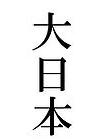
This mark was used during a time in Japan where they were becoming very proud of their country and efforts were being made to establish some sort of pride in where the makers of pottery such as Satsumaware lived and came from
You will quite often see these Kanji on the right-hand side of the marking, denoting that the item was "made in Japan" or of Japanese origin.
I guess that it is just a hallmark to show where the item came from or a way of the maker announcing that they were from that place. If you see a piece with this written on, then you can assume it will be from the Meiji period (1868-1912).
The Shimazu crest.
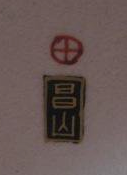
Most old and authentic pieces of Satsumaware will have the Shimazu family crest on, usually at the top of the marking (the red circle with the cross in).
This mark shows that the pottery was made under the rule of the Shimazu clan and is a good way of determining if the item is of value.
The crest is always found at the top of the cartouche. If the item is hand painted, then the markings are more genuine. Some more modern copies have the Shimazu crest, but you can tell them have been stamped or printed with a machine.
Zan
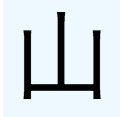
This commonly used marking can mean "mountain" but is often found to be within the name of the maker, eg Gyozan or Kozan.
If you see this marking, it will help you determine part of the name of the maker. The Zan marking can also be read or translated sometimes as "san" too.
Zan can also be marked in a more stylised way, such as on this marking by Gyokuzan, where the "zan" at the bottom looks very different to the normal kanji.
Sei
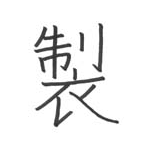
This marking means to "make" or "manufacture" and can be found on many pieces of Satsumaware
I can usually spot this one by remembering the design of the marks below the horizontal like at the bottom. Sometimes, the marks at the top can be hard to identify as they are quite small and have been created by a brush.
Zo
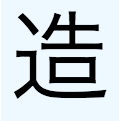
This part of the marking means "to made" or "to manufacture" but can also mean "made by" and is often the last kanji on the marking, written in the bottom left corner.
Many markings will have the "Dai Nippon" mark on the right, the name of the maker on the top left and "Zo" underneath. Reading this literally, you could say that it would mean "Made in Japan by me" (with me being the name of the maker).
Left and Right
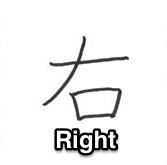
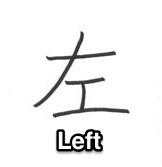
If the pieces are a part of a larger display set, the vases or items will often be marked using information as to where in the line-up they should appear
You will find that the word left or right is followed by a japanese number. You can find a list of numbers here.
Examples of satsuma markings and translations.
Here are a few markings from images of pieces that have been sent to me (many thanks to those that sent them in and please come and "Like" us and join in). I have also put a translation too of the makers name.
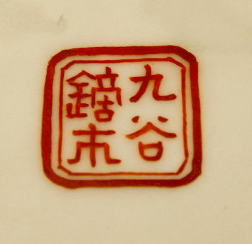
Sozan 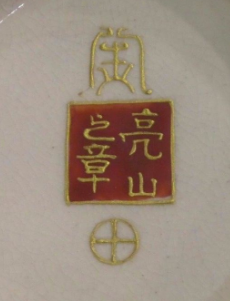
Ryozan 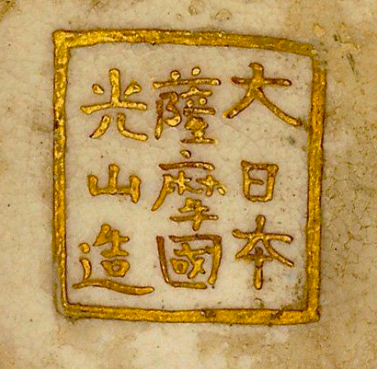
Kozan Zo 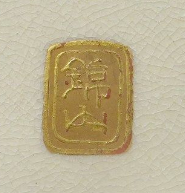
Kinzan 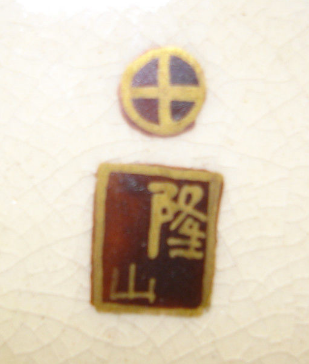
Ryuzan 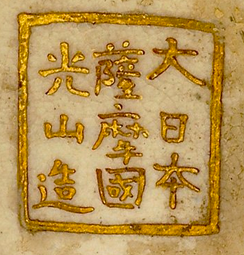
Kozan 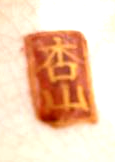
Kyozan 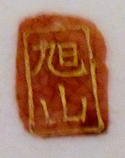
Kyokuzan 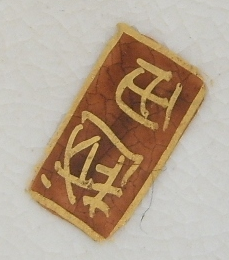
Koshida 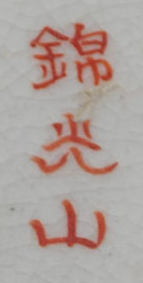
Kinkozan 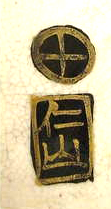
Gyokuzan
322 replies on “How To Read Satsuma Marks”
The picture didn’t upload the first time
Hi, I can’t find any kind of signature/stamp like this. I have a amazing tea set and would like to understand from which time and place it was manufactured.
Thank you
Can someone help me find origin of this I can’t seem to find it anywhere
This is fromm Chinese porcelain, not Japanese
Hello. I have inherited a teapot which I believe based upon markings and style is Satsuma moriage but I would like to know more about the markings and value. I have been told that the first row of the red cartouche on the pot reads “Dai Nippon” but I am unsure of the rest of the markings and would like to know the makers mark.
https://www.reddit.com/r/Antiques/s/ydo0JQRlHK
Could you please tell me this mark
Hi,
I have a ginger jar that was purchased at an auction in the 1920’s. Anyone have an idea about this maker’s mark?
Is this a Kozan mark?
I don’t know the answer, but I have a piece with what looks like the same marking. Did you ever find any info about your piece? I don’t know much about the history of mine, but I inherited it from my grandmother and would love to know more.
I found a tea set with these markings at a garage sale recently and am having trouble finding anything with the same characters. If anyone has any information on it, that would be great! Thanks!
…sorry, I don’t understand if it’s Japanese or Chinese…maybe it’s a generic brand of a modern vase?
hi, I already left a post…now I researched this and it should be toyama ト山 ?? is it vintage or older?…hi
I have a similar one. Did you find anything out? My marking is different
Is this Kozan?
The vase was bought in Japan after world war ii. I need help to translate what it says on the bottom.
Thank you
I need help identifying this mark.
Hi there. I was hoping you might be able to tell me if this mark looks original or not. Found in my local charity shop.
Many thanks
Hi there, I am curious if this means anything on the bottom of my vase lamp. It is sealed shut on top and apparently filled with rocks.
Hello, this was left behind by my late grandmother and hoping for some direction as I’m not sure if it is an antique satsuma pottery, can anyone help? It is a set so can provide more photos if required. Thanks kindly,
Can you please help me identify this mark it is on the bottom of a bronze relief vase?
We have inherited this ‘over the top’ Japanese Satsuma vase with figurines and elephant in relief – 31-32cm in height. We are wondering if the mark can be identified (it has the Zan Kanji) and if the vase has any value. Thank you.
I am interested n this on the bottom of two beautiful Japanese satsuma vases. Thank-you – I love their delicate images. Which flowers would you keep in such vases?
Anyone recognise this mark? we have three plates and the marks are all a variation on this!
Hi – we picked this at a recent sale
Can you tell us if it genuine? Copy ?
If it’s worth anything…. didn’t pay allot for it … Cant find anything at all that matches the design or bottom markings – Thank you
Hey, Pat. Was hoping you could help me identify the attached marking on a pair of vases.
Thanks!
i have this for sale 7869083900
james
hi i’ve got this for sale
Hi, I’d love to know what this slightly-worn marking says. It’s on a lovely ~5″ lobed Satsuma bowl. Could you please help me out? Much thanks!!
Could you please help me identify this mark? Thank you very much in advance for any help.
These characters just say NIPPON (JAPAN).
You can see the same marking on this page at the Gotheborg website under Nichi Hon (Nippon).
I have a vase I believe to be fron Japan, it has a mark on the bottom that was hand painted on. It says jade mountain in Chinese. I was trying to get more information. I found out it’s from Gyokuzan
I hope this is the right place for this. I’ve included 3 pics of a large vase that we’d love to have info on if you don’t mind. Thank you.
I can’t figure this one out! HELP!!
I don’t think it is anything special – not a mark I have seen before.
But the fact that the circle is perfect, makes me think it is a stamp, not a hand painted mark.
Could be tujimuro shijo?? Looks more modern
Hello, I would love to find any information on this mark.
Hi Kamil, did you find anything on this mark? i have one the same and can not find anything?
Did you find anything in that mark please?
Any marking that has English writing is not an antique piece.
I would like to know the meaning and if it has year of manufacture and any significant value. There are 2 pieces, 1 vase and 1 plate.
Zan is pointing the wrong way. Can anyone help?
Hello could you please help me identify this mark in this tea set that my mother in law found on a flea market.
It seems like satsuma porcelain but I really can’t find the marks anywhere and can’t read it.
#3
#2
Hi, can you identify these marks for me? I have no idea about them.
All 3 are on vases.
Thank you for your time
Does anyone know when this pottery was made? Thanks!
Hi and ideas on what this says? thankyou
Marking from a very ornate miniature vase. Any help identifying this is much appreciated.
Hi,
can you tell me what period is that Satsuma bowl? What price is it sold more or less? I Send to you 4 pics.
Thank you very much
Hello..could someone identify this marking on a pair of Satsumi vases please .
Thankyou
This says “right 8”.(I guess that means it should be positioned 8th on the right – part of a set).
Can any one help me please I’m trying to find out what this stamp means. I was told it’s Japanese.
This is Chinese l stating: Ming Dynasty Xuande Era.
Hi, Is anyone able to help me read/ Identify this mark? Im not sure if it’s Japanese or Chinese. Any help would be much appreciated.
Cheers Angie, Australia.
Hi! Can someone help me identify this marking. Wto side’s with different ornaments. Hallmark. Thanks!
Did you find out anything about this vase, i have the same pair of vases
Please help
I have no idea what this says I’ve been looking everywhere with no luck
Hello, I really need help with this.
I have found many seals for satsuma and did think can read many but this i am not able to find?
it is picturing immortals and is 16 inch high!
i am about to pay 2800 usd for it!!!!!
Hi! I was wondering what this means, I bought it from a japan antique store and for trying to understanding the mark or signature but got nothing from the net as of now.
it would be great to know what it means, Thanks! 🙂
I have a vase that I believe is Japanese, but it has a very basic mark on the bottom of just a red rectangle and a separate mark I believe says either “38” or just “8.” Would you help me identify this?
This is a Modern Chinese imitation Satsuma vase.
Hi Tao! Would you please translate these marks? I attempted to look through Kanji lists, but I am just very confused. Thank you for your time -KK
Hi – I am sadly lacking any knowledge in this area. My late mother-in-law was a nurse and in the 60s, an elderly neighbour gave her these two vases in gratitude for looking after her. I’m not at all certain they are Satsuma and am hoping someone can tell me what they are. I’m happy to use the valuing website often mentioned in posts but would like to find out what they are first. Apologies in advance for my ignorance.
Here’s a picture of the vases
Hello! Pretty sure this is a Satsuma “style” piece, but I would like to know more. Thanks for any help!
Any idea if this dish dad bought in Japan in the 1970s is Satsuma?
Hi, the round circle with cross inside at the top means the Shimazo crest.
The middle one I am not sure. The bottom one like an E on it’s side means mountain and from the “zan” or “san” . eg Gyozan or Kozan. Hope that helps.
Hello I have a pair of vases with these markings. Wondering if they’re satsuma or what they say? Thanks so much!
Hi Jen,
I cannot read the two characters on the left, but the two on the right are the name of one of the most famous Chinese emperors of the Qing Dynasty. They are pronounced, roughly, “Chien Long”.
They are Chinese characters stating: made in QianLong (Qing dynasty) era.
Hello, My grandfather left me area set wit this mark… anyone know it or a good resource where I might find it?
I have two vases with these markings on the bottom. They were passed down from my grandparents. Does anyone recognize these markings?
I got a vase and was told it was Satsuma but cannot verify it. Is this a Satsuma marking and if so an approximate age?
i have the same markings any idea age etc
This is likely to be a modern piece. The mark looks to be stamped or printed rather than hand painted and the fact that it has English writing on also makes it more modern. Perhaps 1980’s?
I have the same markings on the bottom of my vase minus the word Japan on it. I have no idea what it means
I also have 6 small (3cm wide) bowls with Geisha on them, andthe same mark which I can’t ID from any of the informative sites. Again any help would be appreciated. Thanks.
Hi there. I have s single saucer which I believe to be Satsuma, but no further info on it. Can you help please?
Hi I posted before and sadly had no one help decipher this. It’s the only thing i have left of my mother’s side of the family and I’d really appreciate if someone could help me out on what this is or says or whom it’s made by.
Hi Aaron.
I believe the marking simply says “SATSUMA” – 薩摩
These 2 kanji are the same as the first 2 ones on the left of the sample seal (with 9 characters in the golden frame). Definitely Japanese.
Can anyone identify this mark on a 27-piece tea set? I can see the “made in Japan” symbols but wonder if it is genuine?
Hello,
Wanted to see if you could help identify this marking.
Thank you for your help.
Conny
Made in China
Hello, not able to find this artist info.
Can anyone help?
Jade mountain sign i do understand that stands for Zen here but rest is mystery for me.
Thank you,
Serge
Hello! I’m just wondering what this means…
Hello, I bought a vase with this same marking. Do you know the year or what it means?
Thanks
Hi,
I just bought these plates and would like some help with what type of plate it is. Not really thinking about selling them but would really like to know more about them.
Dai Nippon. Made in Japan. 1868-1912
Hi! I have a pair of vases with this mark. Does anyone recognize this mark?
Hi, this is a Kutani mark.
My last one Does anyone recognize these markings. I was given as gift
My second one
Does anyone recognize these markings. I was given as gift
Hi Pam.
Satsuma pottery is Japanese. Any item with English writing on (and especially ones made in China) will not be genuine or valuable antiques.
Does anyone recognize these markings. I was given as gift
Satsuma, Dai Nippon-Great Japan
4 characters – 2 on the left = Great Ching (Dynasty), 2 on the right – An emperor “Chien Long”.
Hi, could you please help me identify these markings? Or at least what do they say? It is a pair of Buddha statues.
Thank you!
Hello, Can anyone shed light on this jar, which I assume is Satsuma ware and the marks. Thank you.
It is Kutani ware.
Anyone recognize this?
I am trying to authenticate a set of cups and saucers. They all have this symbol on the bottom. I understand the symbols on the right side and the bottom left symbol that means manufactured in Japan but am unable to find the top 2 symbols on the left side. Help with this would be appreciated.
Ritches auctioneer appraisers in Toronto
your vase reads: “Dai Nippon” (大日本 ‘Great Japan’)
Hi. My Mum passed away early this year and we came across this plate and no nothing about these marks. Any ideas?
This is a Chinese mark. “Made in Qing Dynasty Yongzheng Period”. Here is Wikipedia about Yongzheng Emperor https://en.m.wikipedia.org/wiki/Yongzheng_Emperor
My wife picked this vase up the other day. We are hoping someone can help Identify the Maker, Time Period?
https://www.facebook.com/photo/?fbid=4029617147054011&set=a.467235469958881
https://www.facebook.com/photo/?fbid=4029617123720680&set=a.467235469958881
I have this large pitcher with a red box with gold writing. Is this real or fake?
Trying to identify my vase. I think it’s satsuma shimazu but that’s as far as I could get. Anybody know more?
Hi there, I’ve just bought this vintage tea set, would anyone know maker of this or the year it was manufactured? Just curious lol
Photo of plate
Wonderful site and resource!
I would be very grateful if someone could decipher this mark, form one out of a pair of vases I inherited. I don’t expect them to be valuable or anything, but would love to know some more about them!
Ooohhh, that looks pretty much like this on my late mom’s piece, and for the vase itself I know for sure it’s pre-ww2 made (although it lacks the crossed-circle and the bottom sign looks more like letter “t”) – I’m as well trying to track the origins of it because of nice and interesting story how my late mom got it! I’d appreciate it very much if someone could help with this – thanks in advance!
The t looking symbol is the number 7
Miniature vase
Could anyone help identify an eggshell tea set?
Hi All,
Could anybody identify this mark?
Thank you very much in advance!
Best regards,
Laszlo
Hi
Did you find out what the stamp is as I have a piece with this same marking on
So do I! RH column obviously Dai Nippon. Middle column (below the Shimazu crest) Satsu-ma then ? and LH column is mystifying, doesn’t end in Zho or Sei….? Dai Nippon suggests Meiji period? but sticker suggests not that early? I’m guessing here
did you find out about this marking?
I have one the same.
This feels and seems like ‘real satsumi’ but there is just the faintest of markings? How the heck do you identify something like this. Any help is great!
Hi, I’m trying to work out what this stamp or sign means. Can someone help me out?
The two characters stacked on the right say kutani
The character on the bottom of the left stack is San or Zan. And the characters above that should be a signature
I wonder if you’re familiar with this mark which is on all of the pieces of a gold dragon teapot set, cups and 2 sizes of plates. I’ve looked a lot of places including the one referenced on your page but no luck yet. Thank You
here is the vase. Any comments are appreciated!
here’s the mark
That is the number 13, it could just be a decorators mark to get paid.
Hi is this Japanese authentic or Chinese mass produced. It is a magnificent beautiful image of mt. Fuji nonetheless. Thanks in advance!
Can anyone give me direction on this potty? I have plates, bowls and small tea cups. They all have this mark.
Hi there, is this a replica and if so which country? I love this bowl real satsuma or not.
Here is the only marking
Hi I recently acquired this plate and I was wondering what the mark says and the history behind it and if it might be worth anything.
Hi, Can you tell me anything about this vase?
i have a very similar vase and am also attempting to find more info on it. im in the US and most recently contacted a UK appraiser who told me my 25inch hifgh vase is only worth US $300 to $400??
even if i was to sell it, prob wouldnt let it go for less than $10,000.
I guess truly “beauty is indeed in the eyes of the beholder”
Haha, I have one almost identical, bought in Singapore approx 1910 by my great grandfather. Approx value £300 or £400 and as you say, worth £10,000 to me!
Left 5 (in the display)
Can someone help me identify this marking. Thanks!
I have two Japanese looking vases and I wonder if anyone can help identifying its origin
Hello, I love the pair of vase. Do you want to sell?
It’s 19th century Japanese vases. I have at house many. Do you want to sell? contact me at originalvietnam at g mail
This looks to be genuine satsuma pottery. Plz share the markings beneath to be sure. Thanks
The tea set
Is this a shimazu thea set and which year?
Hey! Do you already know more about the stamp? I have china with the same stamp. Let me know! (I am for the Netherlands)
Hallo Harm na lang zoeken heb ik dit gevonden
Would appreciate help In identifying this mark. Thank you in advance.
This is upside down.
Circle with the cross is shimazu clan usually.
The other two characters say kutani
I was given this tea set and I would like to know if is valuable. I can’t find anything like it online. I think it’s from the mid 1900’s. Any info would be appreciated. Thanks.
I need help with decoding this please.
Sorry if repeating this post.
Looking for info on this mark.
The piece is an incense burner
Any observations on this mark? I could not find it on the Gothenburg site. The piece is an incense burner. Top is damaged but repaired many decades ago.
Looking for some information about my bowl . Kind regards simon
Could you help me identify this mark?
Thank you in advance.
Can you help identify these markings?
Hi Jenny. These is a modern Chinese marking, not Satsuma or Japanese – see the “Yongzheng Nian Zhi, Da Qing – Yongzheng Period Make, Great Qing Dynasty” section here – http://gotheborg.com/marks/20thcenturychina.shtml
Hi sir please help me what is it??
I’m still new, but it says Dai Nippon on the right side, means Great Japan. On the left side, “Eirakuzou”, means Created by Eiraku. Eiraku is a family name and I don’t know which Eiraku painted this.
Can you tell me about these and what they mean?
Did you finally get an answer to this mark?
Could you tell us whether or not this is a genuine satsuma vase? And what these marking mean please? Thank you
Hi Dan. Did you try to attach a photo? I don’t think it worked.
Can you help me identify these?
This looks like a modern piece, not antique. Anything with stamped-on or printed English writing on is more of a mass produced item.
Hello can you tell me if this is a Satsuma mark? It is green on base of a vase. Thx
It looks very similar to the image in the “To Be Identified” section at the bottom of this Kutani page: https://www.gotheborg.com/marks/kutani.shtml
Seems like Satsuma for me, but it is no way to figure out by myself what era and what it says))) Need a little bit help please!
One more pic!
Marking ( closer look)
Hi, I would have said Satsuma from the look of the cup, but the mark close up looks like Kutani
Hi could you provide any information on this set I purchased in Austria. Its satsuma ware, with lithophane geisha girls in the cup. It has a back stamp on the base of the plates. Any information would be gratefully appreciated.
I am trying to figure this symbol out. Any idea, anyone?
Looks like it could be a stylised version of “Bizan”
Can you tell me what these symbols mean on the bottom of a vase I have please
Do you know what this mark is?
it is not showing picture?
Hi. I had some issues with the image upload option.
You can try again, it should be fixed now.
I have a 3 piece set, chocolate pot or tea pot, a milk pitcher and sugar bowl. All with the same pattern and mark but can not identify, please help!
.
Not 100% sure but this mark looks like “Bi” which can mean beautiful.
Trying to identify this mark
Hi! I’m trying to figure out if this set is worth anything! I have a pitcher or chocolate pot, a sugar bowl and a milk pitcher I believe. Please help, I can’t find the marking anywhere
Been searching for mark over 6 months unsure if you can help thank you
Hi Can anyone read what this roundel says, if anything?
its on a c1890 water cistern
If you could tell me more about porcelain
Is My satsuma pottery genuine? If you can tell me more
Is My satsuma pottery genuine?
Hello. Yes, this does look like a genuine piece from the photo but best to get it checked properly.
How can check it
You can look at the resources and guides in the http://www.satsuma-pottery.com/is-my-satsuma-pottery-genuine page.
How can I check a circle with three lines just want to know what it means
Any ideas about this piece?
Hi Sally. Blue and white pieces are normally Chinese, not Japanese.
Voici la paire de ces vases Satsuma ?
Hi Marec. Yes, this does look like an authentic Satsuma piece based on the marking.
Cette paire de vases dont la signature se trouve au fond de chaque vases a t elle de la valeur ? Merci pour votre réponse
Can you please let me know what a red hand painted mark with a gold outline might be. There are 9 symbols with a circle with a cross at the top of the mark . Thanks
I was just wondering if you can confirm this to be a Kinkozan mark. Thanks Steve
Hi there! Was hoping I could get some info on the image I have attached. The vase is about 7” tall. Info and approximate value?
Thanks
Bob
I have two vases given to parents for wedding in 1946 – att 3 pics -1 with markings. The other is a black vase with red/green painted design. Very old / any ideas or thoughts? Ty WG
Hi Wendy. Any item with English words on will be a more modern piece and probably not worth a great deal.
Hi please help me
This is the 12 1/2 ” tall Satsuma Moriage Vase that I got from my aunt after she passed. I was told it was called “The Immortals” and guessing the date she got it was sometime before 1950.
I’m curious about these marking on the bottom of my Satsuma Moriage Vase which I got from my aunt when she passed. Can you tell me anything about them?
I will send a photo of the vase also.
I purchased an asian vase lamp (with what looks to be hand painted butterflies) from Goodwill awhile back. I removed the base to find this marking. If you could provide me with any thoughts, I’d be very appreciative.
I have a pair of vases that I inherited, I would love to have more information on them
Hello,
Could you help me about this marks (porcelain Satsuma arround 1950´s) ?
Thanks by advance,
Best regards,
Ainhoa
Sorry, this is not a mark I recognise.
Did you find out about this mark as I have a whole tea set with it?
uploading a pic of the vase too….thanks
Please let me know some info on our satsuma vase we have in the family. it is about 11.5 inches high
Hi could you help with two black matt and gold vases markings attached please?
Can you give me any more information on this please, thanks
Dear readers, does anyone recognise this satsuma mark. Any idea on maker and approximate date? Many thanks in advance. Marc
…and one more picture of the same item
I am glad to find this forum. I am embarking on the daunting task of identifying a number of pieces. Any input on the attached would be appreciated. Thanks
Does anyone recognize this marking
Is there a way to send a photo of a mark? I’m trying to identify it!
Hi Tamara. I have just updated the comments with the option to upload an image. Give it a shot!
Can’t find this pottery mark anywhere and need help. It is a gold square mark with polka dots surrounding Japanese writing and underneath in square is Japan. Please help. Thank you.
the last mark is not gyokuzan for sure.
What mark do you think it is?
I have two vintage figuringes with a back stamp of a round circle and what looks like straight hair line and a broad grin underneath the circle is JAPAN in red ink. I am just rying to find out who made these of a Japanese Man and Woman. please help me figure this out if you are willing.
Hi Michelle. If these items have JAPAN written in Engish, they will not be antiques and could just be mass produced items.
Help! What is this marking? I understand that it says Japan, but cannot find what the additional marking on the side is…can anyone give me any clues? It is an 11 piece what looks like a tea set, but I can’t seem to find anything like it at all online.
I have a lot of vase and pots they have a red cross and line are they real had for about 25 years
Hi!
I inherited a Satsuma set from my grandparents. They lived in Yokohama. I have been trying to verify age and worth. How can I get a picture to you?
Hi Tina – I am no expert, unfortunately. It would be best to either show the set to a dealer to check or use the online antique valuation service we recommend.
I have a piece although not a very old piece I think. Where can I take it for someone to look at the Mark?
Hi Wendy. You could take it along to any local antique shop for an appraisal. Alternatively, use the online appraisal service that was recommended to us. You send them images and details of the piece and they will provide an age and value.
I HAVE A 1000 BUTTERFLIES CUPS AND SAUCERS
WITH GYOKUZAN MARKINGS
(BLACK WITH CROSS ON TOP
WHAT PERIOD IS THIS (UNUSED )
Hello
Can anyone help me identify this piece of pottery. Size is: Height 17.5 cm. Each side has a different picture as shown in photos. I have also included a photo of top rim and base showing markings. I am not sure if I have taken the correct side for the base as I cannot read/ understand the letters. Any help re origin of vase, date and or value will be much appreciated.
Photo can be seen through this link. I have asked the ebay community but no replies yet. Please help. Thanks.
https://community.ebay.co.uk/t5/Pottery-and-Porcelain-discussion/Help-identify-a-piece-of-Asian-pottery-vase/gpm-p/6175410#M606
Hello,
I’ve recently acquired two small vases which look very similar to some kyo-yaki satsuma vases I’ve seen but I’m unable to find a symbol that matches what is on the bottom of these.
Here’s some images of the vases and their underneath.
https://ibb.co/kJ3yo0
https://ibb.co/cuBUvf
https://ibb.co/fCiL1L
Could you let me know if you recognise this and if it’s genuine? Thank you very much!
EXCELLENT thanks for the information contact@neilmillersbooks.co.uk
Hi there, been trying to find out more about these Japanese teacups, but no luck so far. The mark is hand painted and looks different on every piece, but this one is the most clear. Hope someone can help me to identify it. 🙂
Hello, I have a small satsuma bowl (6″ diameter & 2 1/2″H) millefleur thousand flowers. It has a decal “Japan” and another marking under the glaze. It is a circle with a cross in the middle. It then has a very complicated name in Japanese. Is the circle with the cross from the Shimazu family crest? Also what would be an estimated date of production? Thank you, Briana
Hi! I recently boght this pottery (probably a incense holder) and I would like to find out if it could be real Satsuma or not. I hope you can help. Thank you.
https://ibb.co/jbmmHK
https://ibb.co/kEgmHK
https://ibb.co/kJOBjz
https://ibb.co/dbChre
Hi Lili.
Firstly, the mark sort of looks genuine to me but I worry that it might be a stamped or printed mark rather than hand painted. The “20” on there also worries me that it would be real. The one thing that really makes me worry is that I have never seen an antique Satsuma incense holder before.
I have a piece of pottery that was decorated by Maria Longworth Nichols in 1895 but has a red mark I believe to be Japanese… is it possible she acquired the piece from Japan? It’s red with two lines, then a perpendicular line next to a box with a line through it.
Hi Jennifer. I don’t know this artist but I guess it is possible? Does she have a history of decorating pottery rather than making it herself?
You could try to work out the marking by constructing the Kanji here.
I found a vase 3ft high. I believe it’s a satsuma. Its beautiful. I can’t seem to find any markings. I would love to send a picture to know more about if it’s old or a satsuma for sure.
Hi Joy. If there are no markings, you would have to have it properly checked. Take a look at the online antique evaluation service we recommend.
I have a vase and the only marking on the bottom says Satsuma and Japan, is this vase just a worthless copy?
Hi, this is most likely a mass-produced piece, not a valuable antique.
I have an ornament of about 12 inch tall that I think is Japanese it’s been in our family for over 70 years that I’m aware of but maybe more it has a imprinted fruit symbol with writing within it how can I date and find its origin spent hours looking for it
Hi Rick. It is likely that if the mark is imprinted rather than hand-drawn it will be a more modern piece.
If you have drawn a blank online, try using the online antique evaluation site we recommend. I know others here have had good results.
Hello,
I’ve been attempting to identify this Japanese tea set, it has no markings on the bottom except for 3 red lines on the bottom of the teapot. It looks like this: 三
Here’s a picture of an identical set, can’t find any specific information on when and who it was by. https://www.worthpoint.com/worthopedia/antique-japanese-kutani-satsuma-1000-1829648785
Hi Sage – that marking looks like the Japanese number 3. If there is no specific mark from a maker then it is likely to be a more modern copy made in the Satsuma style.
I have three teapots of descending sizes. A paper label notes: “signed with crest of prince of Satsuma” (they are from the estate of my stepmother, who was a professional dealer of antique glass & china). The crest consists of a gold circle and a cross within it on a red background.
Your image of the Shimazu crest shows the circle and cross in red (not gold) with no paint of any color behind them–just the pottery showing through.
Was the gold circle & cross on red, which is found on my teapots, correctly identified by my stepmother? (She was dedicated, but I have no illusions that she was perfect!)
Hi Lynn. It is likely that these are more modern pieces. Anything with English writing on will not be antique.
My name isThomas, and I have been trying to find this out how to price my vase and I have been running into walls left and right. Could you possibly help me with this? Please and thank you. I’ll send you a picture
Hi Thomas. I am only an interested collector, so will not be able to help value or even identify your piece. I have used the valuation service Satsuma Pottery Valuation Servicehere before and it is pretty accurate.
Hi ,
I found a small vase (10cm) in my mother in law’s household. It has a handwritten stamp with red colour and gold writing that says 富山 薩广 … I was wondering if the vase is fake , because of the second kanji of satsuma (or is that a possible way to write it). Is there such thing as Toyama satsuma ? And if it’s real do you think small vases do have any value? Thank you so much for any information.
Hi Mariam. It does sound like it might be an antique. Have you considered an Satsuma Pottery Valuation Serviceonline valuation service to see what they think? Toyama could be the name of the maker.
Hi,
I own a complete Kutani tea set but am having trouble researching it & was wondering if you could give me any info please? It has 6 x cups & saucers, 6 x side plates, 1 x larger round serving plate, milk jug, sugar bowl with lid & tea pot. The milk jug has a clear mark on the bottom that can only be seen when you get it in the right light. It says: Kama Palm Tea above a box containing 九谷 then KUTANI under the box. All the other pieces have printed in red: DECORATED IN HONG KONG. The set set is a floral pattern on a gold background. I believe it was purchased early 1900’s. Many thanks,
Anne
Hi Anne. This sounds like a mass produced copy made in the Kutani style. Also, Kutani is Japanese, so if it is made in Hong Kong, then that is an immediate giveaway that it is not an antique.
Thanks Teo, Was just curious.
Hello,
Wanted to see if you could help identify this marking: https://pix.sfly.com/6t-AmW I was told it is antique Satsuma, but I have not been able to identify through online research.
Hi Lisa.
This mark simply says “Satsuma” – it is quite messy though and was hard to decipher!
Hi Tao,
Thank you for the information, I appreciate the quick response. Any idea of period and, with it being messy 🙂 any idea if the hanko is real? It’s a beautiful vase, would be sad to think it’s not truly Satsuma: https://pix.sfly.com/sMW2ur
Hi Lisa. I can’t really say what period it is from. You would have to get it appraised to get a better idea.
Thank you Tao, I appreciate your help and responses.
This site was very helpful to help identify a Kinkozan mark. Thanks so much!
Thanks LJ!
If SATSUMA IS PRINTED ON THE BOTTOM OF THE PIECE, what does that mean.
Hi Wilmer. It would mean that it is a newer piece not made in Japan, but probably a mass-produced copy in the Satsuma style.
I have a small porcelain teapot with crude red circle with two gold lines with smaller circles on them as the mark on the bottom. It is richly decorated with a boat on one side and figures on the other. Does anyone know when it may be from. Thanks
Hi Simonne. I can’t really say if it is genuine, but it does sound as if the marking is like one you would find on an antique piece.
I have a vase it’s satsumaware the has family mark gold leaf painted and the openings trimmed in white someone Thur it’s history put hole in bottom I guess for lamp are these worth restoreing. 15 in tall 28 in round. The mark on bottom missing from hole?
Hi Howard. It’s a shame that people make them into lamps, although, I get the idea!
I suspect that it is a more recent item (not a valuable antique) but can’t say for sure. You would need to have it looked at by a Satsuma Pottery Valuation Serviceprofessional antique appraiser.
hi I have family crest on its own, a red circle with red cross and what looks like a blob or triangle on outer of circle, do you know what this marking is please
Hi Lotus. It does sound like an original marking (antique) have you been able to find it on the Gotheborg site?
I have two satsuma pieces which I would like to find out about need help
Hi Mandy – have you checked out the online valuation service we recommend? You will probably get the answers you need there.
I like to suggest a few improvements concerning the translations of the Kanji names under the pictures of your marks.
– Dia Nihon Satsuma Kozan Zo must be: Dai Nihon Satsuma Kuni (國) Kozan Zo.
– Ryozan = Ryozan no Sho (之章).
– Sozan must be: Kutani Kaburagi (九谷 鏑木).
– Gyokuzan (is written: 玉山) must be: Jinzan (仁山).
Perhaps it’s possible to adjust the text under the pictures?
Greetings,
Martin.
Thanks Martin – every extra bit of information helps my visitors!
You obviously have some experience in this area!
Hi I need help with my Satsuma Moriage with Depict 4 Geisha Near to the river vase, I really I don’t know what is mean T in the bottom vase. I Try to find some similar like my but only I find one, the same hand painted but with at other depict in front. I ready in this Satsuma Moriage Vase is from 1900 but still the same question MY vase have T letter engraved, no stamp, no paint. Please help. 🙁 🙁
My ‘satsuma’ has LD or something that looks like it underneath, its two similar vases with Japanese paintings in vibrant colours and gold .they stand at about 30cm high.What are they?
Hi
I am trying to identify this mark from a vase. https://flic.kr/p/UyUyLq
Appears to be the Shimazu clan mark at top and from brief research the basic kanji seems to be ‘earth’
Any further information would be greatly appreciated.
Thanks in advance
Glenn
I have a flower vase w lid ..makes r n japan writing! ! Can u help me if i send a picture of mark???
Please can anyone identify this mark
Hello! Thanks for the great references! I am still having trouble identifying this particular mark, and wondered if you could help. Thank you kindly!
Lindsey
I have a satsuma vase that has Satsuma printed in the middle of the vase bottom in a rectangle box. It also has the number 4 in a box and the number 31 too. There is a number 91 or 16 and a number 8 under a horizontal line and to the left of a vertical line. It is very colorfyl and has raised gold beaded designs.
Hi Pat.
Thanks for getting in touch.
Items with “SATSUMA” (written in English) are not antiques and are usually mass produced items.
I have a pair of moriage vases with dragon handles showing a court scene.They are 15 1/2″ tall and have 4 holes in each top rim.The only marking on them are is a small red paint symbol (both different) under the bases
Can anyone help with this please? It’s Shimazu, but I can’t date it.
https://farm9.staticflickr.com/8657/30561844065_ae81f56ce8_m.jpg
Looks like it might read “Yuzan” or “Yunzan” as the name of the maker? – there is also the black markings to the right, which look like a + (meaning 10) and O (meaning zero).
Hi.
I have what I think is a Satsuma Egg, but it has no markings. I have pictures of it. Should it have markings to be of value ?
Thanks,
Linsi x
Hi Linsi.
Satsuma Eggs are funny things – I have a feeling (not backed up by any research) that all Satsuma Eggs are not real.
What I mean by that is that I have yet to find a genuine antique egg (with the correct markings on). There are plenty for sale on eBay that say they are a “genuine antique satsuma egg” – but the image of the marking often shows something like “Made In China” – which totally destroys their claims 🙂
However, they do sell – but the bigger the egg the better the price. Check out the sold eggs on eBay for more info.
on eBay for more info.
Thank you and that makes complete sense. I don’t suppose the marks make too much of a difference on the price. It’s large and cool looking so for my $20 not too much of an investment. Thanks again.
Hello I have a really nice large vase with a lid that is ornately decorated which has a reddish brown (maroon) background throughout. It reads hand painted and Satsuma and something else I can’t read and has a triangle with an 8 in it and separately has a mark of a rectangular with 2 possible letters or numbers? One on top of the other. Like an N and underneath it’s hard to say… Maybe a 3, 8, S and has 3 dots around all of it and above that mark it has another triangle but the mark is to fuzzy to read at all. It appears very old but in great condition but I can’t find a lot online about these marks.
If the marking as any words in English – “Hand Painted” or “Satsuma” then it is a more modern (less valuable) mass produced copy of the antiques.
Hello, can you please help me identify this mark?
Yuzan – Meiji period I think…
Hello, can you please help me identify this mark? I believe it is Meinji period. Thank you.
I cleaned this one off a bit
here is the full view.
this is an antique satsuma porcelain egg. why would it be painted and not stamps. some of the ones I see online are stamped but this is hand written along with something else I cant make out. found in my attic the person who originally brought here is from Japan and it was brought back after the war.
Hello.
Please give information about the vase. When it was made?
About its price?
Size-50-60cm
Thanks in advance!!!
Can you tell me what the maker mark is please? approx year? Thanks!
Hears my other pic
Could someone please tell me about this marking on my bowl.. Will try add more pics
Could someone tell me about this marking please..
Hi could anyone tell me anything about this marking please
Could anyone tell me about this marking please..
…
hi this porcelain sign known? He has a value? thank you
Helps if you can see what I’m asking about 😉
This is from a Satsuma vase,any information greatly received
Here are the photos.
I’m not sure about the artist name but the second mark is the Yasuda Co. under the shimazu family crest. Two famous artist from the are Seikozan and Ryozan but I’m not sure if any of them is the artist. I doubt this is from 1853. probably late 19th century to early 20th century.
Reportedly from 1853, anyone know the artists or value? It is part of a 22 piece tea set.
You can find this mark on Gotheborg website. It is generic Satsuma mark.
Anybody know what this means…I think it says Takayama Do sei??
Looking to find more info on this mark on the bottom of my jar. Any info would be of great help.
Hello, I would love to find out any information on this Japanese tea or coffee set. I purchased this from an estate auction. It had been in storage over 20 years. Many very nice antiques in this sale. It is very delicate and appears to be very old. I would call it porcelain with heavy raised gold applied. Can you tell me anything about this set? Thank you so very much!
It is a Chocolate pot set early 20th late 19th C. Kyoto porcelain ..about 100 to 250 on Ebay.
Thank you so very much answering my question about the chocolate set!
Janie
You are welcome.
Hi, My grandmother gave me as a wedding gift, her own 12 piece tea set, which she said was a Satsuma pottery set. I would very much like to know if it’s an original (antique) and how much would it be worth today. I have taken some pictures and I hope someone will tell me its worth.
Thanks,
Toni
The cup and saucer are Satsuma turn of century 1900, worth somewhere in area of 100 to 300 each set,